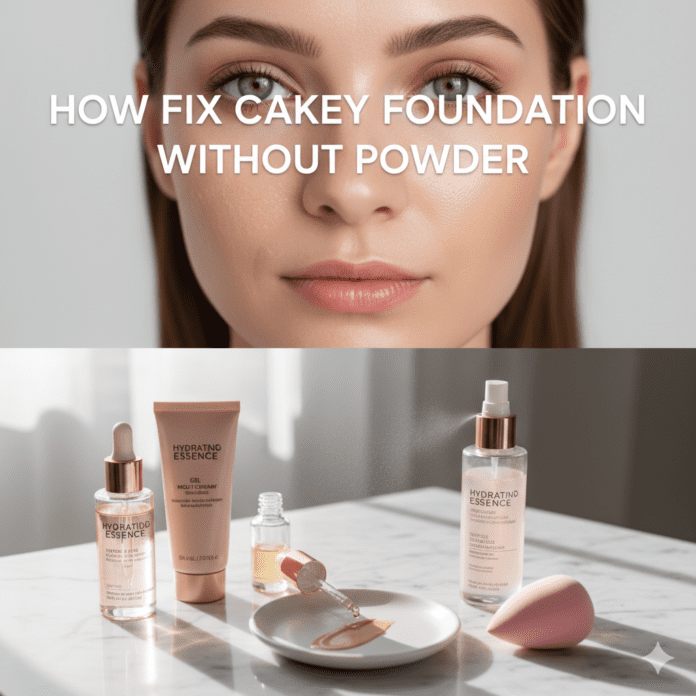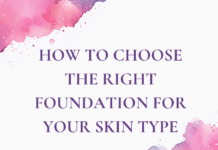We’ve all been there. You spend time carefully applying your makeup, only to glance in a mirror a few hours later and see it: the dreaded “cakey” foundation. Instead of a smooth, seamless complexion, your makeup looks heavy, dry, and has settled into every fine line and pore. The common impulse is to grab a pressed powder and pat more on top, but this often makes the problem ten times worse, adding another dry layer to an already struggling base.
What if the secret to a perfect complexion wasn’t about adding more product, but about a complete shift in technique?
How to Fix Cakey Foundation Without Powder
Learning how to fix cakey foundation without powder is a game-changer. It’s about mastering the art of skin preparation, application, and using the right tools to make your foundation melt into your skin, rather than sitting on top of it. This comprehensive guide will walk you through the root causes of cakey makeup and provide step-by-step tutorials and pro tips to achieve a radiant, natural finish that looks and feels like you’re wearing nothing at all.
Table of Contents
- Why Does Foundation Look Cakey? Understanding the Root Causes
- The Foundation of Your Foundation: A 5-Step Skincare Prep Blueprint
- Flawless Application Techniques: How You Apply Matters Most
- The Mid-Day Rescue: How to Fix Cakey Foundation on the Go (No Powder Needed!)
- Pro Secrets for a Seamless Finish
- Frequently Asked Questions (FAQ)
1. Why Does Foundation Look Cakey? Understanding the Root Causes
Before we can fix the problem, we need to understand why it happens. “Cakey” is a term we use when foundation appears thick, heavy, or textured. It can manifest as flakiness on dry patches, separation around the nose and mouth, or creasing under the eyes.
The culprit isn’t always the foundation itself. Here are the most common reasons your base makeup looks less than perfect:
- Dehydrated Skin: This is the #1 cause. When your skin is thirsty, it absorbs the water content from your foundation, leaving behind a concentrated layer of pigment that clumps and looks dry.
- Excess Dead Skin Cells: An uneven skin surface full of dead cells prevents foundation from laying down smoothly. It clings to these dry patches, causing a flaky, textured appearance.
- Using Too Much Product: In the quest for coverage, it’s easy to apply too much foundation. A thick layer is more likely to move, crease, and look like a mask.
- Incorrect Application Technique: Wiping or smearing foundation across your face can cause streaks and disrupt the layers of skincare underneath.
- Wrong Formula for Your Skin Type: Using a heavy, mattifying foundation on dry skin, or a super dewy formula on very oily skin, can create an imbalance that leads to cakiness or separation.
- Skipping Primer (or Using the Wrong One): A primer creates a smooth barrier between your skin and makeup. If your primer and foundation aren’t compatible (e.g., a silicone-based primer with a water-based foundation), they can repel each other and cause pilling.
2. The Foundation of Your Foundation: A 5-Step Skincare Prep Blueprint
A flawless makeup application begins long before you even pick up your foundation bottle. Think of your skin as a canvas; the smoother and more hydrated the canvas, the better the paint will look.
Step 1: Gentle Exfoliation (The Game Changer)
Removing the layer of dead skin cells that causes foundation to cling and flake is non-negotiable. However, harsh physical scrubs can cause micro-tears and irritation. Instead, opt for a gentle chemical exfoliant 2-3 times a week.
- For Dry/Sensitive Skin: Lactic acid or Polyhydroxy Acids (PHAs) are excellent choices as they exfoliate while also hydrating the skin.
- For Oily/Acne-Prone Skin: Salicylic acid (BHA) helps to clear pores while smoothing texture.
Expert Insight: “You cannot achieve a smooth makeup application on a rough surface. A liquid exfoliant with Alpha-Hydroxy Acids (AHAs) a few nights a week will dissolve the ‘glue’ holding dead skin cells, revealing a much smoother canvas for your foundation.”
- Product Suggestions:
- Budget-Friendly: The Ordinary Lactic Acid 5% + HA
- Cult Favorite: Paula’s Choice 2% BHA Liquid Exfoliant
- Gentle: COSRX AHA/BHA Clarifying Treatment Toner
Step 2: Drench Your Skin in Hydration
Hydrated skin is plump, bouncy, and allows foundation to blend seamlessly. This is different from moisturizing (which involves oils to seal everything in). The key is to layer thin, watery products.
- Facial Mist/Essence: After cleansing, spritz your face with a hydrating mist or press in an essence to dampen the skin.
- Hydrating Serum: Apply a serum with ingredients like hyaluronic acid, glycerin, or snail mucin onto your damp skin. This helps the serum pull that moisture deep into your skin layers.
- Product Suggestions:
- Essence: COSRX Advanced Snail 96 Mucin Power Essence
- Serum: The INKEY List Hyaluronic Acid Serum
Step 3: Moisturize for Your Skin Type
Now it’s time to lock in that hydration with a moisturizer. This creates a protective barrier and further smooths the skin’s surface.
- Oily/Combination Skin: Look for a lightweight gel or gel-cream that hydrates without feeling heavy.
- Dry/Normal Skin: Opt for a cream with ceramides and lipids to nourish and support your skin barrier.
Pro Tip: Give your moisturizer at least 5-10 minutes to fully absorb before moving on to the next step. This prevents your makeup from pilling.
- Product Suggestions:
- For Oily Skin: Neutrogena Hydro Boost Water Gel
- For Dry Skin: La Roche-Posay Toleriane Double Repair Face Moisturizer
Step 4: Sunscreen (The Non-Negotiable Final Skin Step)
Sunscreen is essential, but a thick, pasty formula can ruin your makeup. Choose a cosmetically elegant sunscreen that feels more like a serum or moisturizer and doesn’t leave a white cast.
- Product Suggestions:
- For a Natural Finish: Biore UV Aqua Rich Watery Essence
- For a Primer-Like Feel: Supergoop! Unseen Sunscreen SPF 40
Step 5: Choose a Hydrating or Smoothing Primer
A primer is the bridge between your skincare and makeup. For avoiding cakiness, skip the heavy, mattifying silicone primers. Instead, choose one that focuses on hydration or smoothing pores.
- Product Suggestions:
- For a Tacky, Makeup-Gripping Base: Milk Makeup Hydro Grip Primer
- Affordable Alternative: e.l.f. Power Grip Primer
3. Flawless Application Techniques: How You Apply Matters Most
With your canvas prepped, it’s time for the main event. These techniques will ensure your foundation looks like a second skin.
Tool Time: Damp Sponge vs. Brush vs. Fingers
- Damp Beauty Sponge (Best for a Non-Cakey Look): This is the holy grail tool. A damp sponge soaks up excess product, ensuring you never apply too much, while the bouncing motion presses the foundation into the skin for an airbrushed finish.
- Fingers: The warmth of your fingers helps melt the product, creating a very natural, skin-like finish. Best for light coverage or tinted moisturizers.
- Foundation Brush: A brush can provide more coverage but is also more likely to cause cakiness if not used correctly. If you use a brush, make sure to follow up with a damp sponge to press it all in.
Step-by-Step Tutorial: The “Press and Roll” Method
- Start with Less: Dispense just one pump of foundation onto the back of your hand. You can always add more.
- Dot, Don’t Swipe: Using your finger, dot the foundation primarily on the center of your face—cheeks, forehead, and chin—where you typically need the most coverage.
- Press and Roll: Take your damp sponge and begin bouncing it gently on your skin. Use a stippling or “press and roll” motion. This melts the product seamlessly. Avoid wiping or dragging the sponge.
- Blend Outwards: Work the product from the center of your face outwards towards your hairline and jaw. This creates a natural gradient, leaving the least amount of product on the perimeter of your face.
- Build in Thin Layers: If you need more coverage in a specific area, apply another very thin layer using the same bouncing motion.
4. The Mid-Day Rescue: How to Fix Cakey Foundation on the Go (No Powder Needed!)
You’ve followed all the steps, but due to humidity, oil, or a long day, you see some separation. Here’s how to fix it in minutes.
Step-by-Step Tutorial: The 3-Step Emergency Fix
- Blot Away Excess Oil: Before adding any moisture, you must remove the oil that’s breaking down your makeup. Gently press a blotting sheet (or a thin tissue/toilet seat cover in a pinch) onto shiny areas like your T-zone. Do not rub. This absorbs the oil without lifting your foundation.
- Rehydrate with a Fine Facial Mist: This is the magic step. A facial mist will re-liquefy your foundation, making it pliable again. Hold the bottle about 8-10 inches from your face and spritz lightly. The key is to use a mist with a very fine sprayer so it doesn’t leave large droplets.
- Product Suggestions:
- For a Dewy Glow: Caudalie Beauty Elixir
- For Melting Makeup: MAC Prep + Prime Fix+
- Product Suggestions:
- Press and Re-Blend: While your skin is still slightly damp from the mist, take a clean finger, the clean side of your makeup sponge, or a small concealer brush and gently press over the areas that looked cakey or had separated (typically around the nose, mouth, and under the eyes). This will re-blend the foundation seamlessly back into your skin.
The Final Seal: A Dewy Setting Spray
After re-blending, a final spritz of a quality setting spray can lock everything in place and give you a beautiful, skin-like finish. This is different from a facial mist; a setting spray contains polymers that form a flexible film over your makeup.
- Product Suggestions:
- The Gold Standard: Charlotte Tilbury Airbrush Flawless Setting Spray
- For Ultimate Longevity: Urban Decay All Nighter Vitamin C Setting Spray
5. Pro Secrets for a Seamless Finish
- Mix it Up: Add a single drop of a non-comedogenic facial oil or a liquid illuminator into your foundation on the back of your hand before applying. This sheers out the formula and adds a beautiful, healthy glow.
- Go Cream-Based: Powder products (blush, bronzer) can instantly add a layer of texture. Try using cream blush and bronzer over your foundation, blending them in before you use any setting spray.
- Underpainting: A technique used by celebrity makeup artists. Apply your cream contour, blush, and concealer before your foundation. Then, apply a very thin layer of foundation on top using a damp sponge. This creates a soft-focus, “lit from within” look.
- Target Your Concealer: Instead of applying foundation heavily under your eyes, use a lightweight, hydrating concealer only where you need it after your foundation is blended. For more information on skin-safe ingredients, check out resources like the American Academy of Dermatology Association.
6. Frequently Asked Questions (FAQ)
Q1: Why does my foundation always look cakey around my nose and mouth? This is extremely common. These areas have a lot of movement from talking and facial expressions, and the crevices around the nose are prone to oil buildup. The best fix is to use the least amount of product possible in these areas and use the “press and re-blend” technique with a mist throughout the day.
Q2: Can I still use powder if I want a non-cakey look? Absolutely, but with strategy. The key is to move away from heavy “baking” or all-over powdering. Instead, use a very finely milled, translucent powder on a small, fluffy brush. Tap off the excess and lightly press it only where you get very oily, such as the sides of your nose and the very center of your forehead.
Q3: Does a more expensive foundation prevent cakiness? Not at all. A $15 drugstore foundation applied with proper skin prep and technique will look infinitely better than a $70 luxury foundation dabbed onto dry, unprepared skin. The formula’s compatibility with your skin type and your application method are far more important than the price tag. As explained in beauty publications like Allure, technique is paramount.
Conclusion
Fixing cakey foundation isn’t about finding one magic product; it’s about adopting a holistic approach that prioritizes skin health and mindful application. By focusing on exfoliation, deep hydration, and pressing your products into the skin rather than painting them on, you can finally achieve that coveted flawless, second-skin finish. Ditch the heavy powders and embrace these techniques—your skin will thank you for it.







